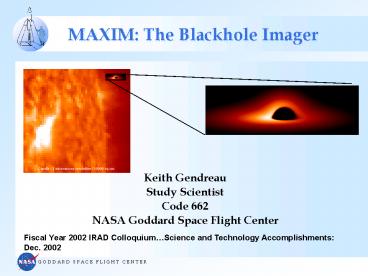MAXIM: The Blackhole Imager - PowerPoint PPT Presentation
1 / 13
Title:
MAXIM: The Blackhole Imager
Description:
Discover where AGN Jets take off. Study Stellar Coronae. http://maxim.gsfc.nasa.gov ... All s/c act like thin lenses- Higher Robustness ... – PowerPoint PPT presentation
Number of Views:50
Avg rating:3.0/5.0
Title: MAXIM: The Blackhole Imager
1
MAXIM The Blackhole Imager
- Keith Gendreau
- Study Scientist
- Code 662
- NASA Goddard Space Flight Center
Fiscal Year 2002 IRAD ColloquiumScience and
Technology Accomplishments Dec. 2002
2
Science Driver for MAXIM
- Current best estimates for the size of the event
horizon of a blackhole a few microarcseconds - Variability and spectral data describe an x-ray
bright region near the event horizon. - Baselines at 1-10Å are a factor of of 1000
shorter than at 1000-10000Å - The MAXIM mission will have resolution of 0.1
?as. - Resolve the event horizon
- Study physics and dynamics of inner accretion
region near event horizon - For Scientific and Technical context, we are
exploring MAXIM Pathfinder mission concepts. - Discover where AGN Jets take off
- Study Stellar Coronae
http//maxim.gsfc.nasa.gov
3
Science Driver for MAXIM
4
Supermassive Blackhole Targets
- The distances are calculated assuming a Hubble
constant of 65 km/s/Mpc. Accurately determined
kinematic black hole masses are denoted by an
asterisk. All other black hole masses are
estimates based upon reverberation experiments or
host galaxy properties. All of these sources are
known to possess variable fluxes we quote a
typical value in the 2-10 keV bandpass.
5
Objectives for FY02
- Testbed Development
- This year we planned to get fringes in 1-D of a
scaled version of the MAXIM X-ray interferometer
at 1 keV - Test tolerances of a grazing incidence
interferometer - Advance Mission Concepts
- Make the Pathfinder mission true stepping stone
to the full mission - Look for new methods to point micro-arcsecond
imagers - Identify technological tall Poles
6
Accomplishments for the Year Testbed Development
and Results
- Detected fringes _at_ 0.525 keV (23 Å) and 1.49 keV
(8.35 Å) with a 650 micron baseline (0.1 at
1.49 keV) - There are several significant implications of
this years work - We have demonstrated interferometry over a factor
of 3 of wavelength within the X-ray band. - Our measurement at 8.35 Å is the shortest
wavelength light to have produced fringes in a
broadbandpass interferometer. - We have successfully proven a core MAXIM concept
Fringes at 8.35 Å 25 November 2002
7
Accomplishments for the Year Testbed Development
and Results
L
d
Beams Cross
Flats
Detector
- Grazing Incidence softens tolerances by 2
orders of magnitude. Optics that are diffraction
limited for normal incidence UV is diffraction
limited for grazing incidence X-rays. - Use simple optics to keep diffraction limit.
- Demonstrated in lab at 10 Angstroms (1.25 keV).
W. Cash et al, Nature 407 14 September 2000 - Demonstrated at GSFC with 23.6 Angstroms
27September 2002
s
Fringe Spacing
8
Accomplishments for the Year Testbed Development
and Results
- Penthouse of Bldg 2
- 80 m long X-ray beam line
- 25 m source to optics
- 50 m focal length
- 1mm baseline
- (0.25 arcsec at 1 keV)
- Fringe Spacings of 75 to 250 microns-gt simple
vibration suppression at 3 stations
9
Accomplishments for the Year Mission Concept
Development (I)
- Improved Grouping of Mirrors Periscope Pairs
- Easy Formation Flying (microns)- It was
nanometers - All s/c act like thin lenses- Higher Robustness
- Possibility to introduce phase control within one
space craft- an x-ray delay line- More
Flexibility - Offers more optimal UV-Plane coverage- Less
dependence on Detector Energy Resolution - Each Module, self contained- Lower Risk.
- Offers the Pathfinder Mission higher resolution
than in our baseline mission - Makes the Pathfinder Mission scalable towards the
full Blackhole Imager - Completed an IMDC Study using this concept along
with new pointing techniques for new scalable
MAXIM-gt cost est 550-600M
10
Accomplishments for the Year Mission Concept
Development (I)
Improved Mirror Grouping
Pre FY02 Baseline Mirror Grouping
Group and package Primary and Secondary Mirrors
as Periscope Pairs
- Easy Formation Flying (microns)
- All s/c act like thin lenses- Higher Robustness
- Possibility to introduce phase control within one
space craft- an x-ray delay line- More
Flexibility - Offers more optimal UV-Plane coverage- Less
dependence on Detector Energy Resolution - Each Module, self contained- Lower Risk.
Full MAXIM- the black hole imager
- Nanometer formation flying
- Primaries must point to milliarcseconds
A scalable MAXIM concept.
11
Accomplishments for the Year Mission Concept
Development (I)
1 km
Science Phase 2 High Resolution (100 nas)
Science Phase 1 Low Resolution (100 mas)
Launch
200 km
20,000 km
Transfer Stage
12
Accomplishments for the Year Mission Concept
Development (II)
- Line-of-Sight Alignment Pointing sub
milli-arcsecond telescopes - Needed to find alternates to using SIM as a star
tracker - Completed an ISAL study for the super
startracker - Compared traditional star tracker approaches to
inertial reference frame approaches - Identified specific challenges
- Found that High Precision Gyroscopes may be
the solution - Started a new collaboration with UMD on Super
Fluid Gyroscopes - Could offer higher sensitivity and a much higher
bandpass than the GP-B gyros - Multiple uses
13
Future Work X-ray Interferometry Testbed
- Improve stability of testbed with more thermal
control - Attempt to lock in on fringes
- Extend the wavelength range of our testbed to the
Iron K X-ray line - Interferometry at less than 2 angstroms- an
extension of more than an order of magnitude - Our interferometer will work at wavelengths where
we know the inner regions of a blackhole are
bright - We will need a longer facility
- Extend testbed to 2-D
- Bring into phase a 3rd set of mirrors
- Make larger mirrors
- Integration with the Formation Flying Testbed
- Compensate for building motion
- Provide more definition for mission concept
studies































